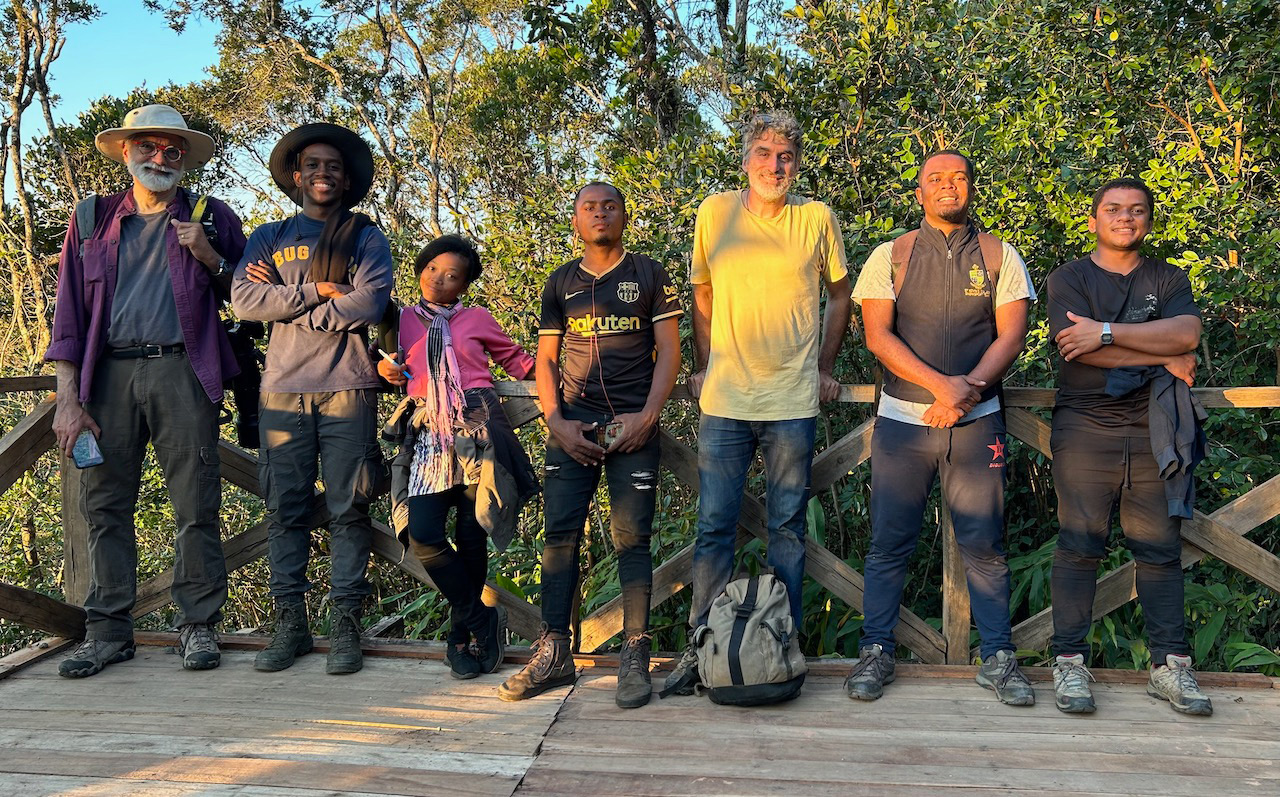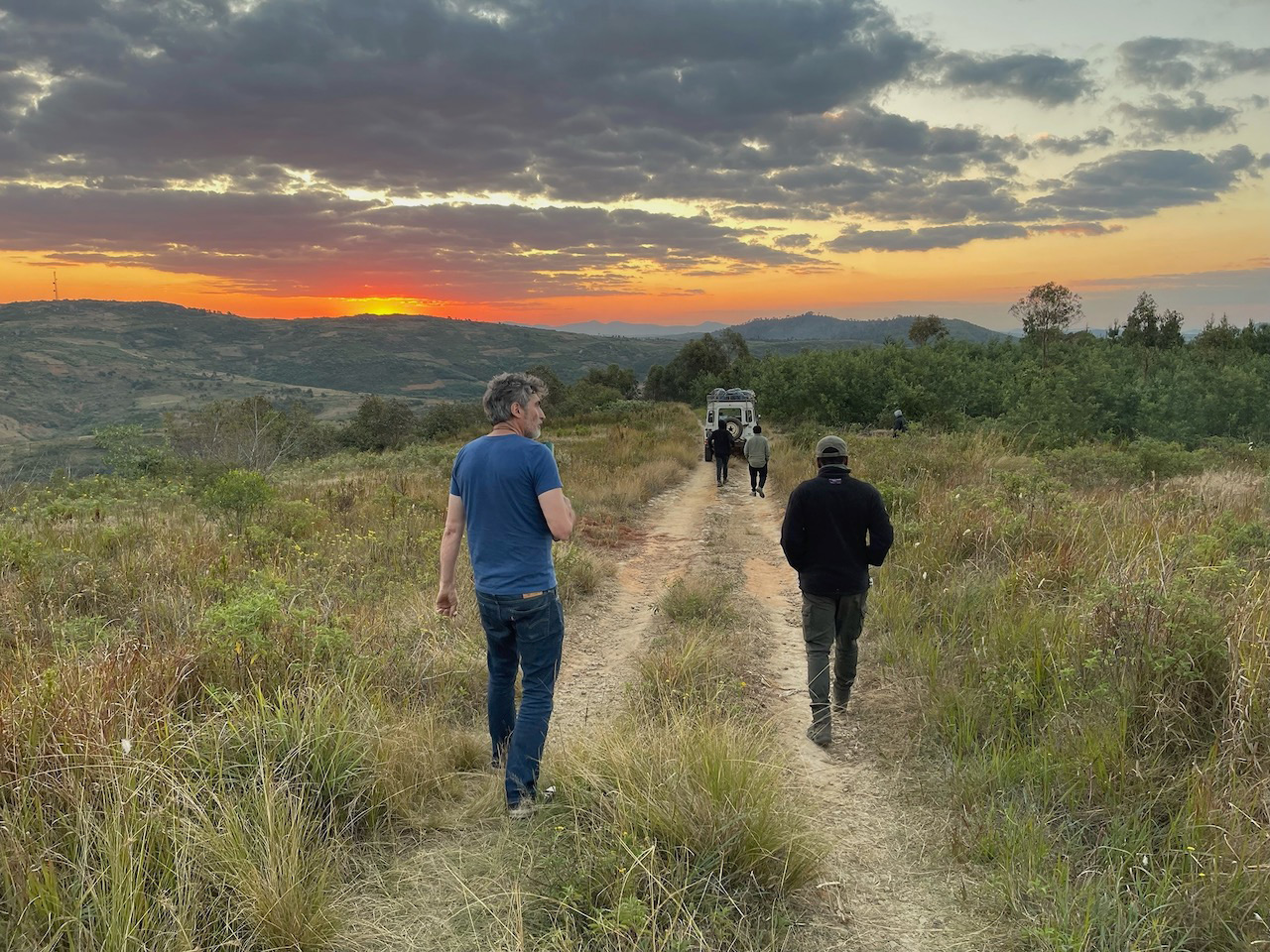Interview with Dr. Chris Raxworthy
by Johanna Mitra, ICTE/CVB Communications Officer, Interview Date June 16th, 2023

Photo by Johanna Mitra, 2023
Dr. Christopher Raxworthy is the curator of the Department of Herpetology at the American Museum of Natural History and professor at the AMNH’s Richard Gilder Graduate School. He has studied reptiles and amphibians in Madagascar since 1985 and found and described many species new to science, many in Ranomafana. Along with Dr. Patricia Wright, he was featured in Peter Tyson's book "The Eighth Continent: Life, Death, and Discovery in the Lost World of Madagascar"
What’s brought your research team down to the eastern rainforests of Madagascar?
I’m here today at Centre ValBio with a student group from the University of Mahajanga to give them a sense of the eastern rainforest reptile and amphibian community. We’ve been working on the high plateau, so I wanted to drop down to the eastern escarpment and Ranomafana was perfectly placed to bring the students down to a slightly lower-elevation forest. Even though it's the start of the wintertime, I’m hoping that we’re going to see a lot of the species still active!
Your herpetology work has taken you all around the world. Is there anything that has struck you as being very unique to Madagascar when it comes to the reptiles and amphibians here?
Madagascar is amazing in that there are certain groups here that have become these very species-rich radiations, like chameleons and the Madagascar gemsnakes. In both of those groups, we’re still finding species new to science and it looks like they’ve evolved to a diversity of maybe 80 to 100 species that are locally endemic. Madagascar also has a number of evolutionary relics. For instance, both the Madagascar side necked turtle and the Madagascar iguanas’ closest relative are in South America, which is mind-blowing. There’s also a striking contrast between the reptiles here and in Africa, as many African groups never made it to Madagascar…But I would say overall, what makes Madagascar really special is that the diversity of species in reptile and amphibian groups here is really high. That raises a really interesting question—why are there so many species in Madagascar? I’ve basically spent my whole career nibbling away at that question, trying to understand the drivers of speciation in Madagascar. As an isolated system and a tropical area where the climate is a little more stable than temperate areas, Madagascar is perhaps one of the best places on this planet to study speciation, biogeography, and evolution.

Photo by Diamonde, 2023
Can you describe your first time visiting Ranomafana?
I first came to Ranomafana in 1990 when the forest wasn’t a [national] park yet. Dr. Patricia Wright had just built the research cabin in the forest…and the trails were still being developed. The cabin was a simple structure but at that time, it was the nucleus. That’s where all the researchers stayed, and when it rained, that’s where you went to get shelter. What made Ranomafana really exciting was that because it's in the southeast of Madagascar, there was quite a big difference in the species that are found here in comparison with the much more well-known areas at that time around Andasibe. Of course, many rare lemur species were also being described at that time too. And for reptiles and amphibians, it was an amazing place to come to because again, the species that were found in this area were poorly-studied, and it was very difficult logistically to get around Madagascar and do research work. Even with that simple wooden structure, it was already a facility in terms of coming to do research.
Do you have any particularly memorable stories from your time conducting research in Ranomafana?
I remember one time I had [specimen collection] permits and about halfway through my time here, we decided that we would walk down to Ranomafana… It was nighttime and I had a headlamp… We’re walking along when suddenly I saw this relatively recent roadkill snake on the road. Like all good herpetologists, I always had a reptile bag on me, so I collected it… Afterwards, when I got it back, fixed it, and identified it, it was Ithycyphus perineti—the first record of this snake from this part of Madagascar. A couple of years later, John Cadle was doing work with snakes in Ranomafana and he said it was the last species of snakes that he found in this area when he compared his list to mine. So it kind of demonstrated that you can have these very fortuitous moments when you least expect them.
Ranomafana is also the place I’ve had the best views of aye-ayes. I’ve spent a lot of time out in the forest at night but only ever had poor views of them, as they’re very secretive and always run away. But this particular time, we were hearing the aye-ayes calling and when I looked up, there was one on a tree trunk! What really struck me was its enormous black bushy tail. That’s always the image I conjure up when I talk to people about aye-ayes—the aye-aye I saw at Ranomafana.
What are some challenges you’ve faced in your work in Madagascar?
The logistics are always a challenge. You have to have time to work in Madagascar and to get to more remote sites, you’re talking about sometimes walking long distances. To really explore Madagascar adequately, you have to be very good at planning field logistics. Some people also get nervous about the tropics when it comes to things like tropical diseases, but I’ve never been too concerned about that. After that, it really comes down to your energy and your enthusiasm.
There are so many pluses to working in Madagascar, in terms of the excitement of making discoveries and also feeling like you’re making a difference. It's really satisfying to me to see all our biodiversity data that has been collected over the years being used to justify creating new protected areas and for helping to initiate funding for sustainable development projects. I actually gave a tour recently in Madagascar and I was reflecting on the fact that when I first came here in 1985, we were all saying there will be no forest left in 30 years’ time. Now it's more than 30 years from then, and there’s still substantial areas of forest that are in good condition. People often get a bit pessimistic about the future of Madagascar, but I’m quite optimistic. Madagascar has quite an extensive protected area network and there’s a lot of value put on biodiversity here. The other thing that’s pleasing for me to see is how the capacity in Madagascar has really increased over the last 30 years. Now, I’m actually teaching the students of my first students that I ever trained in Madagascar! We’ve now got a large cohort of Malagasy herpetologists that know the fauna really well, and we have multiple research collections at universities…
Speaking of students, Centre ValBio hosts many undergraduate and graduate students interested in becoming researchers and continuing their field work in Madagascar. Do you have any advice for them and other aspiring scientists?
I think they’ve already taken the first piece of advice, which is to come to Madagascar! If you’re at a university or school where you’ve got the opportunity to study abroad or come take a class here—take it! It’s such a special place and it can be life changing. You can come here and really get inspired, and ultimately, develop a whole career that could be based around Madagascar or other tropical research. But no matter what happens, if you come to Madagascar, your life will be changed in some way.
Once you’re here, I think what’s really important is that obviously, you walk in the forests and see the environments, but that you also try and absorb as much as you can about Malagasy culture, and understand, to the extent possible during the time that you’re here, what the broader context of Madagascar’s biodiversity is in terms of the people and the politics. It means that the next time you come back to Madagascar, you can be a lot more independent. The other thing that is worthwhile mentioning is to try and get your French up to speed. Madagascar is still very much a francophone country and the more French you can speak before you come to Madagascar, the more interactions you can have. Ultimately, you’ll want to learn Malagasy, but even just a short course in French will really help you.
Are there any developments in the field of herpetology that you’re particularly excited about, or any upcoming projects or research questions you’ve been focusing on?
One of the big issues that I’m looking at at the moment is climate change. Reptiles and amphibians are found everywhere here, but that includes at the tops of mountains. We can see that species are responding to a warming climate by moving to higher elevations, just to stay at the same temperature range they’re adapted to. But there’s a lot of species that are already rare and found close to the summits of Madagascar's highest mountains. With a warming planet, they’re going to be migrating up and eventually, run out of space. So I’m concerned about what’s happening with those mountain faunas. The first thing is to get baseline data—determine what species are where and what their current distributions are. Then we need to think about the future in terms of starting to monitor those populations. In some cases, we may be dealing with species that will be on the verge of extinction quite quickly, so the impacts of climate change in Madagascar could be really dramatic.
I’m also really interested in other aspects of Madagascar. For example, with Madagascar chameleons, there are many species here but we’re getting to a point now where we’ll want that diversity described and to have a really good understanding of their distributions. In this case, the chameleon group is going to be a very good one to look at processes of speciation in Madagascar and what has made Madagascar so rich in species.
And I guess the final thing is—although there’s never a final thing in Madagascar— I do think there are more important forests in Madagascar that aren’t yet protected…so it's important to keep attention focused on that. One of my students that's here now, Ivan, is actually studying fragments of forest in Madagascar and how as forests become fragmented and smaller in size, they lose species. So, you basically have extinction occurring on a local scale. We’re hoping to understand the pattern of that extinction and edge effects and then use that to ultimately look at how to manage fragmented forests effectively and maximize their species richness.
And lastly, I heard there was something of personal interest to you that brought you down to CVB - can you share about that?
One of the members of the research community here at Centre ValBio collected a skink in Southwest Madagascar and sent some photographs of it to me. The photographs were of a skink in the genus Pygomeles that are not well known, and not known at all in that part of Madagascar. Sometimes you just get these situations where you’re at the right place at the right time and an unusual specimen pops up. So I’m really excited to have a look at the skink, try and figure out if it’s a described species or something new, and if it is something new, it's really important that it gets described and put into a collection. You never know in Madagascar!

Photo by Sahid Naeem, 2023
